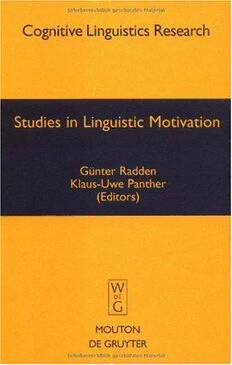
Studies In Linguistic Motivation (Cognitive Linguistic Research) PDF
399 Pages·2004·26.534 MB·English
Most books are stored in the elastic cloud where traffic is expensive. For this reason, we have a limit on daily download.
Preview Studies In Linguistic Motivation (Cognitive Linguistic Research)
Description:
How much of language is motivated? Recently, cognitive and functional linguists have proposed new solutions to this intriguing question. The thirteen articles collected in this volume cover various aspects of motivation in grammar and in the lexicon. The motivation underlying grammatical structure is demonstrated in chapters on "ecological niches," expressive constructions, grammaticalization (emergence of aspect, basic verbs), the grammar of motion and fictive motion, predicate adjective constructions, grammatical functions of reduplication, anaphoric reference, and the recategorization of paragon names as common nouns. Motivation in the lexicon is shown to exist in semantic change and in meaning extensions leading to polysemy. The phenomena discussed in the contributions can be grouped into four types of motivation, which, along with other types, are explicated in the introductory chapter: ecological motivation, i.e. motivation of a linguistic unit due to its place, or "ecological niche," within a system; genetic motivation, i.e. motivation of present-day linguistic behavior or structure due to historical factors; experiential motivation, i.e. motivation that is based on embodied experience; and cognitive motivation, i. e. motivation that is based on human knowledge and cognitive operations such as metonymy and metaphor. The languages studied in some detail include Afrikaans, Croatian, Dutch, English, French, German, Hausa, and Hungarian. This volume makes a strong case for the pervasiveness of motivation in natural language.
See more
The list of books you might like
Most books are stored in the elastic cloud where traffic is expensive. For this reason, we have a limit on daily download.
